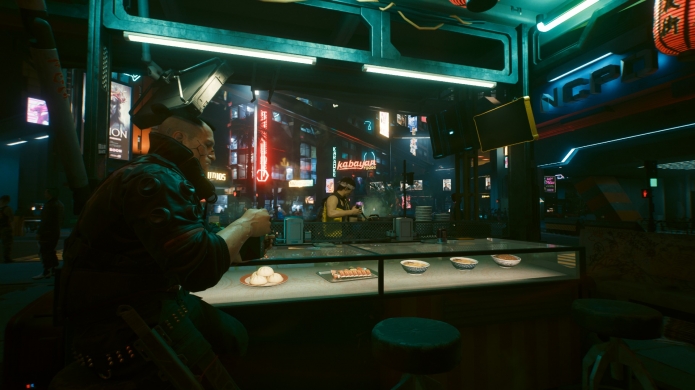GeForce RTX 4060 Preview - Cyberpunk 2077, DLSS 3, and Incredible Ray-Traced Visuals
Post by KostaAndreadis @ 11:00pm 26/06/23 | Comments
The GeForce RTX 4060 is out this week, and NVIDIA let us check out the new mainstream GPU early to see what DLSS 3 brings to Cyberpunk 2077 and the still-gorgeous Night City.

All images in this article were captured from Cyberpunk 2077 with RT Ultra settings on the GeForce RTX 4060 with DLSS 3 enabled.
With the upcoming release of the star-studded Cyberpunk 2077: Phantom Liberty expansion (where you’ve got both Keanu Reeves and Idris Elba), the game is back in the headlines for several reasons. First, the new expansion looks fantastic and introduces a new region of Night City to explore in what’s described as a “futuristic spy thriller” by the development team at CD Projekt Red.
Secondly, it’s set said to overhaul just about every aspect of the game, from skill trees to the UI to finally bringing a proper GTA-style policing system to exploring the sights and sounds of Night City. Cyberpunk 2077’s redemption arc is complete, and we couldn’t be happier. And this is on top of the game being in an excellent state last year when we got the brilliant Cyberpunk: Edgerunners series on Netflix.
On PC, Cyberpunk 2077 has always impressed - as long as you had the hardware to take advantage of the impressive real-time ray-tracing effects in the game. From reflections to shadows to emissive lights, it’s still one of today's most visually remarkable (and demanding) PC games. At the time of its launch back in 2020, if you wanted to enjoy the ray-traced beauty of Night City, you needed a capable GeForce RTX GPU alongside the magic of NVIDIA’s AI-based DLSS Super Resolution technology.
From reflections to shadows to emissive lights, Cyberpunk 2077 is still one of today's most visually remarkable (and demanding) PC games.
What makes the RT in Cyberpunk 2077 still one of the most impressive showcases for what the technology can bring to games is the fact that on its highest settings, beyond what even the PlayStation 5 and Xbox Series X can deliver, you’ve got a seamless and cinematic futuristic city to explore with no actual loading screens or transitional speed bumps to take you out of the action. You can go from a neon-lit nightclub out into a dark alleyway and then through some bustling rain-soaked streets in a matter of moments, and with ray tracing, it all takes on a filmic Blade Runner-like quality.
DLSS 3 Goes Mainstream
Okay, so one of the significant advances that arrived with the GeForce RTX 40 Series (as seen in our reviews of the GeForce RTX 4090, RTX 4080, and RTX 4070) is the new Ada Lovelace architecture and the vastly improved AI hardware found inside. With new specialised Optical Flow Acceleration, the hardware takes the impressive DLSS upscaling (which boosts performance without impacting visual quality) and adds another layer of AI magic.

Related: Moving to Night City - Why it's Time to Celebrate Cyberpunk 2077
And we say that because DLSS 3 encompasses three bits of NVIDIA technology into a single package; DLSS Super Resolution, NVIDIA Reflex, and Frame Generation. As the name suggests, Frame Generation uses AI to create new frames to boost performance. It’s technical sorcery of the highest order and has seen massive quality improvements since it debuted last year regarding the quality of the AI-generated frames. When enabled, you won’t notice anything glaring or off; it all looks as it should. And that’s a commendable achievement.
The adoption rate for DLSS 3, the number of games that support it, is also higher than what we saw with DLSS 2. Although exclusive to the GeForce RTX 40 Series due to the specialised AI hardware requirement, DLSS 3 is turning the idea of a generational upgrade on its head. Much like DLSS 2 has, where raw performance is no longer the be-all-end-all.
In the case of Cyberpunk 2077, which fully supports DLSS 3 and makes full use of the technology thanks to its incredible visuals, the only real question after we saw the GeForce RTX 4090 in action was whether or not DLSS 3 would still work when it comes to the GeForce RTX 4060.
Although exclusive to the GeForce RTX 40 Series due to the specialised AI hardware requirement, DLSS 3 is turning the idea of a generational upgrade on its head. Much like DLSS 2 has, where raw performance is no longer the be-all-end-all.
After all, the RTX 4060 is the mainstream release for the GeForce RTX 40 Series and will sell more units than the high-end enthusiast models in the long run. This is not uncommon, as per the latest Steam Hardware Survey Results; the most popular GPUs currently in the hands of PC gamers are products from the xx60 line-up: your GeForce GTX 1060, GeForce RTX 2060, and GeForce RTX 3060 graphics cards.
Although we’ll dig into the results in a second, seeing Cyberpunk 2077 running on the MSI GeForce RTX 4060 VENTUS 2X supplied by NVIDIA with “RT Ultra” settings enabled at 1080p at over 100 frames-per-second is mind-blowing. It not only looks great but feels great to play too.
Cyberpunk 2077 RT Ultra Performance on the GeForce RTX 4060
This is not a full review of the MSI GeForce RTX 4060 VENTUS 2X or the GeForce RTX 4060, merely a preview and real-world look at 1080p performance in Cyberpunk 2077 with RT Ultra settings enabled. There were no restrictions on what locations in the game to visit or benchmark, or even what other GPUs to compare performance with; we were simply provided the GPU and told to jump into Night City using the RT Ultra settings at 1080p with DLSS tech-enabled using the Balanced setting and Frame Generation.

Related: MCyberpunk 2077's Phantom Liberty Overhauls the Entire Game
With that starting point, we were able to dig up a few older GPUs in the lab, a GeForce RTX 2060 SUPER Founders Edition (which is basically a GeForce RTX 2060 Ti) and a premium ROG Strix GeForce RTX 3060 OC Edition from ASUS, to pit against the brand-new GeForce RTX 4060 - in MSI GeForce RTX 4060 VENTUS 2X form. With DLSS 3 and Frame Generation exclusive to the GeForce RTX 4060 out of these three cards, the direct comparison comes with a look at DLSS 2 Super Resolution.

Here we can see that the jump in performance going from the GeForce RTX 2060 SUPER to the GeForce RTX 3060 OC is 25%, and an additional 20% when going from the GeForce RTX 3060 to the GeForce RTX 4060. For those that upgrade or are looking at getting a new gaming PC every other generation (which is how most people do it), this paints a great picture of the GeForce RTX 4060—a 50% performance improvement from the SUPER variant of the GeForce RTX 2060 when playing Cyberpunk 2077.
Seeing Cyberpunk 2077 running on the MSI GeForce RTX 4060 VENTUS 2X supplied by NVIDIA with “RT Ultra” settings enabled at 1080p at over 100 frames-per-second is mind-blowing.
Turn on DLSS 3, and you see this figure jumps up to an incredible 129% improvement in performance with the help of AI. Compared to the GeForce RTX 3060, it’s still an amazing 83% uplift and a clear example that raw hardware grunt presents only one part of the picture regarding the GeForce RTX line-up.
And we also see the impressive power efficiency of the GeForce RTX 4060, with the card drawing only 133W of power compared to 171W for the GeForce RTX 2060 SUPER, and 161W for the GeForce RTX 3060.
There is one concern when it comes to Frame Generation and DLSS 3, and that’s latency. The time it takes for input commands to register can make a game feel sluggish or unresponsive, even if the frame rate is high - as is the case with DLSS 3. The good news is that with DLSS 3 enabled on the GeForce RTX 4060, PC latency stayed within the 50-60ms range thanks to NVIDIA Reflex, the company’s low latency technology mostly found in competitive titles. It’s a crucial part of what makes DLSS 3 work because it also makes the game feel smoother, in addition to seeing the frame-rate numbers climb.
Compared to DLSS 2 with Reflex turned off, DLSS 3 is an across-the-board improvement from frame rate to latency. Of course, you can enable Reflex without Frame Generation for a slight performance hit to improve latency, but that takes a back-seat to triple-digit Cyberpunk 2077 RT Ultra performance. On the mainstream GeForce RTX 4060, Cyberpunk 2077 looks better than what either current-gen console can produce, and a reminder that it’s still one of the most stunning PC games available today.
This makes the upcoming release of Cyberpunk 2077: Phantom Liberty all the more enticing.
The GeForce RTX 4060 launches June 29, and Cyberpunk 2077: Phantom Liberty is out September 26.
Read more about Cyberpunk 2077 on the game page - we've got the latest news, screenshots, videos, and more!
























